People
How Can You Make Art for ‘Trying Times’? For the Longtime Artist Couple Carrie Moyer and Sheila Pepe, It’s All About Teamwork
The pair collaborated on a joint show at the Portland Museum of Art in Maine.
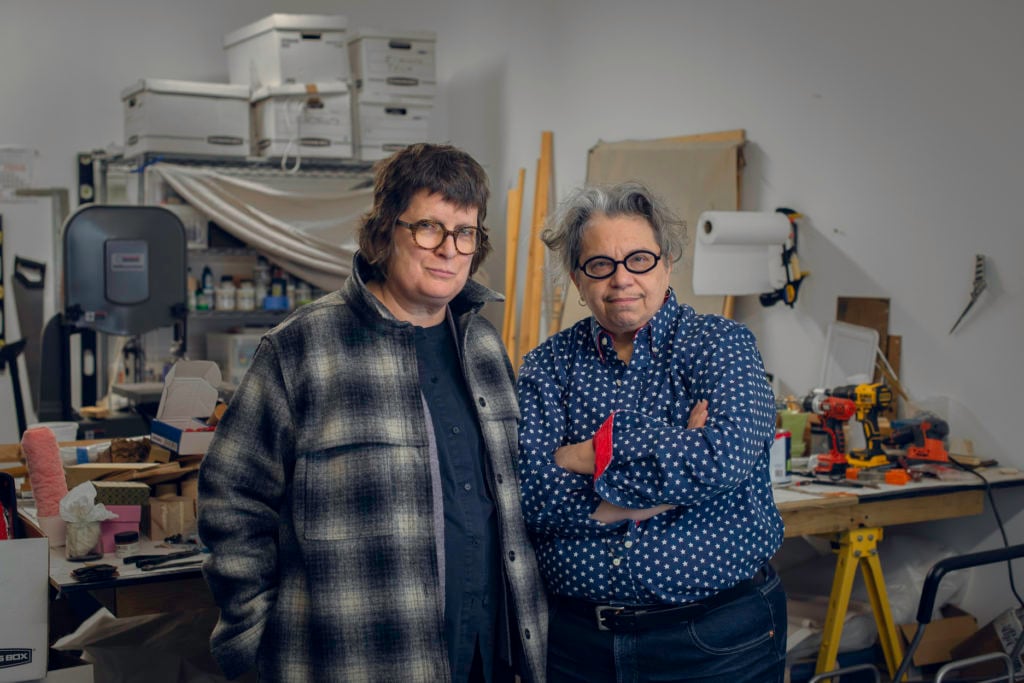
The pair collaborated on a joint show at the Portland Museum of Art in Maine.

Carrie Moyer and Sheila Pepe, partners in life and—occasionally—art, met in 1995 at the Skowhegan residency in Maine. Now, a quarter of a century later, the two have returned to the northeastern state for their first institutional collaboration.
Occupying the middle gallery at the Portland Museum of Art (PMA), their show, “Tabernacles for Trying Times,” is loosely conceived as a kind of sanctuary where visitors can come together and worship at the altar of contemporary art.
The exhibition centered on a pair of works the two artists co-created for the occasion, including a sprawling, ceiling-mounted installation and a series of spiritually inclined drawings.
The installation looks like what you might expect from the pair: a network of woven fibers is connected by drooping pieces of fabric that have been painted by Moyer. It feels like the work of a spider viewed through the lens of an acid trip.
The other collaboration—a symmetrical set of illustrations depicting ornate eaves and cornices that together form a kind altar—is less obvious, but not less interesting. It’s what happens when two well-established artists meet in the middle and see what happens.
Shortly after the PMA exhibition opened, Moyer and Pepe sat down with Artnet News to discuss their collaborative process.
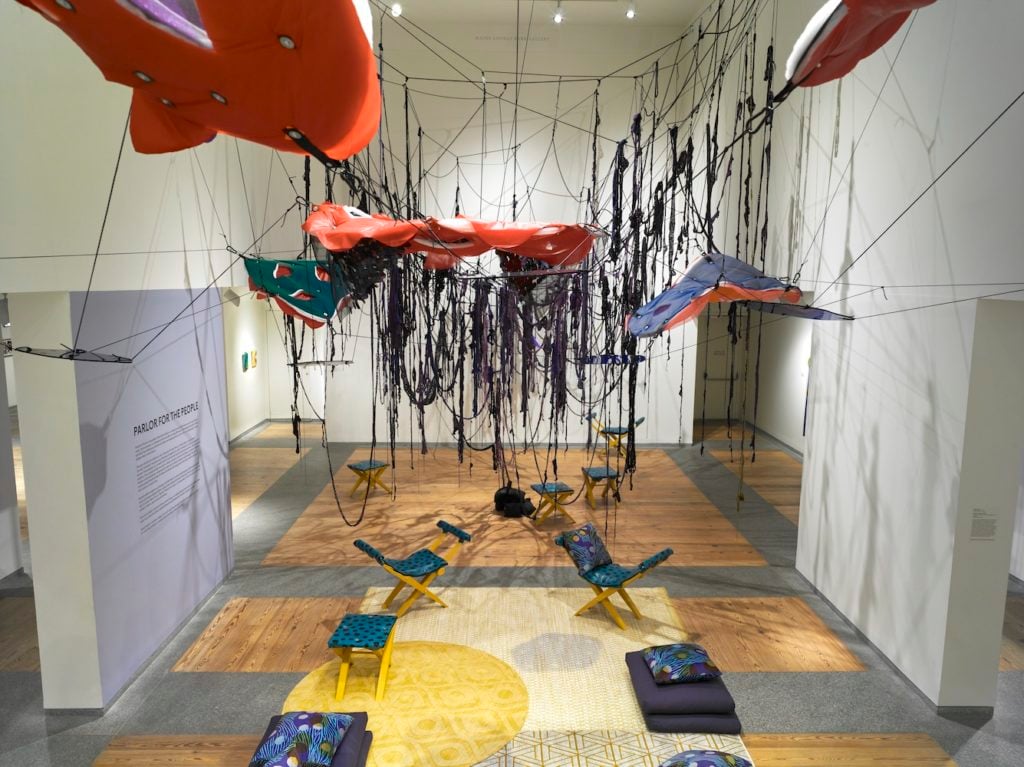
Installation view of Carrie Moyer and Sheila Pepe: Tabernacles for Trying Times” at the Portland Museum of Art. Courtesy of the Portland Museum of Art.
How did the show come about? What was the idea behind it?
Carrie Moyer: The genesis of the PMA show was that the curator, Jaime D. Simone, read Sharon Louden’s book The Artist as Culture Producer, in which I wrote about meeting Sheila at Skowhegan. [Simone] was tasked with programming artists who had some relationship with Maine. We’ve both been to Skowhegan a lot—I’m a governor there—and Sheila’s been to the Haystack School of Crafts many times too. So we have a great love of Maine and associate it with good things. I mentioned in that essay that Sheila and I had worked on some small collaborations together while doing residencies at Yaddo and at the Joan Mitchell Foundation.
Shiela Pepe: Most recently we collaborated at the Civitella Ranieri Foundation, which is in Umbria. That was more focused because we already knew we would have the PMA show. We got the residency and then we got the show and it was like, “Oh, this is perfect.”
Did you apply to those residencies together?
SP: We apply as collaborators. The first time, when we went to Yaddo around 2011, it was like, “Oh, this’ll be fun. We’ll do a little collaboration and see how it goes.” We made our own work and then we did a few things together.
CM: It was very modest to begin with because we weren’t sure if it would work. We’d basically pass the object back and forth between the studios. Then we went to the Joan Mitchell Foundation in New Orleans and again, we pitched it as a collaboration. We were there for a month together in this huge studio, which was insane. And we were more ambitious.
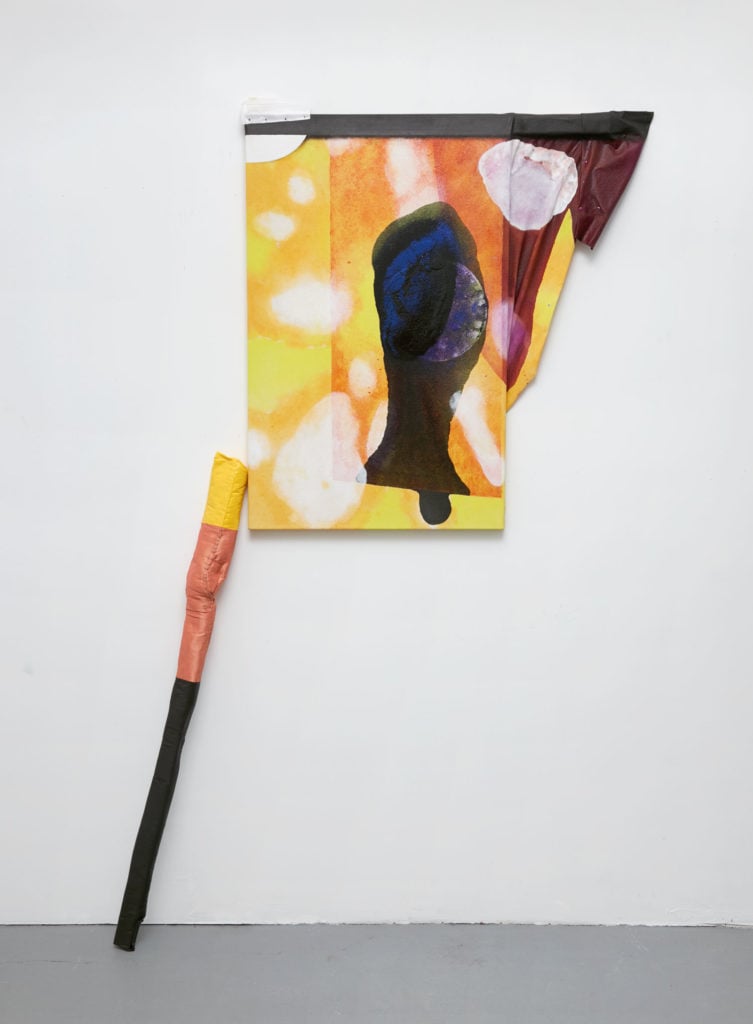
Carrie Moyer and Sheila Pepe, Carries a Soft Stick (2016). © the artists.
You collaborated on two new artworks for the PMA exhibition as well, including the central piece, Parlor for the People. What was the process of making that like?
SP: This was the first time where it was like, “Carrie, can I paint? Give me a brush!” Then I would paint and she would say, “Okay, let me fix it.” [Laughs.]
CM: Yeah, I was the cleanup woman. [Laughs.] We have very different aesthetics. The works we made are funky and precise in certain ways. They feel like they’re made by a third artist, you know? I think if you pull any of that collaborative work into a space that was devoted to either one of us, it would look like it was a sibling.
SP: If we had a kid and that person made art, that’s probably what it would look like.
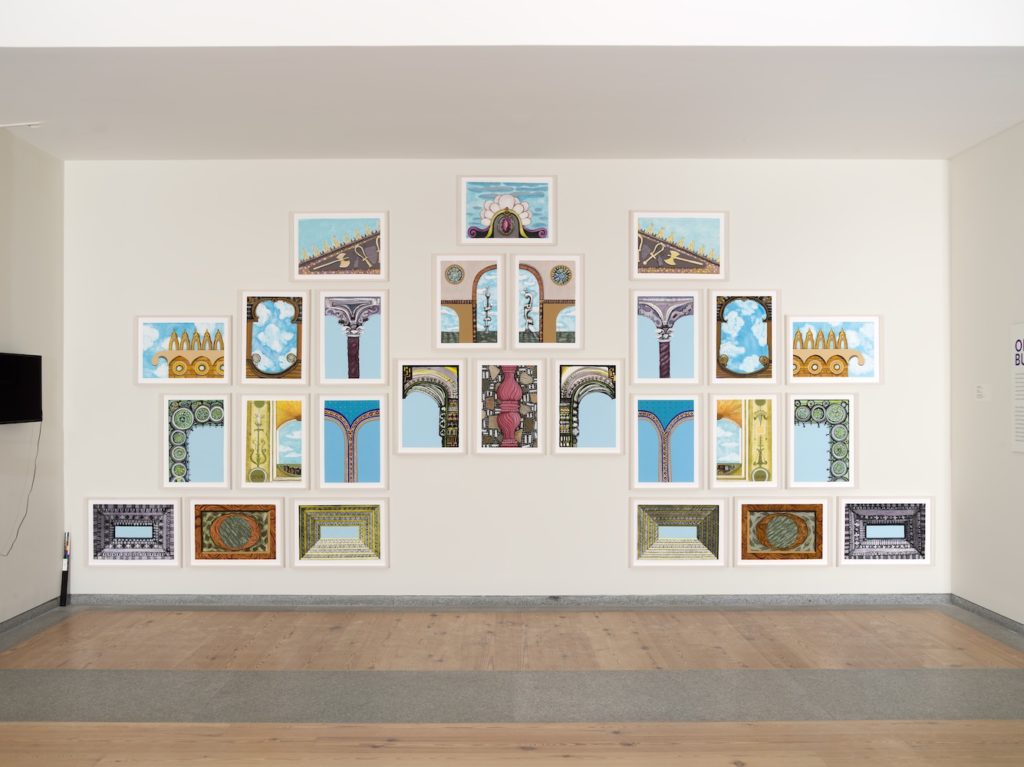
Carrie Moyer and Sheila Pepe, Opera Buffa (2020). Courtesy of the artists and the Portland Museum of Art.
CM: The other collaboration we did for this show is this installation of 26 drawings made when we were at this residency in Italy and traveling around and looking at churches. One of the interests that Sheila and I share is in how compositional devices in religious art operate, like a mandala or an altarpiece—these things that sort of fix your gaze in a space that’s meant for meditation. So that was something that we played with in this work on paper, which is called Opera Buffa. You’ll notice they’re paired drawings—we each would make a pair and then as we got towards the center, we worked together on some, passing the drawing back and forth, exquisite corpse-style.
The thing that our collaborations rely on is setting up a system before we do it. So each time we work together, we have a different formula. It took us two weeks to sit on all this new information we’d been getting in Europe, all the things we’d been looking at. Finally, Sheila came up with the thought of creating our own altarpiece because we’re both interested in symmetry and Sheila has a native relationship to religion—she grew up Catholic. I am interested in a more ambient kind of spirituality. I’m always referring to mid-century nature painting in my work—people like Marsden Hartley and Arthur Dove. Those are people I think of as being my ancestors.
SP: Also, because we both grew up in modernism, there’s this understanding for us that art can be a secular place of spirituality. I don’t think I understood transcendence as a kid, but art always felt expansive; it felt like church to me.
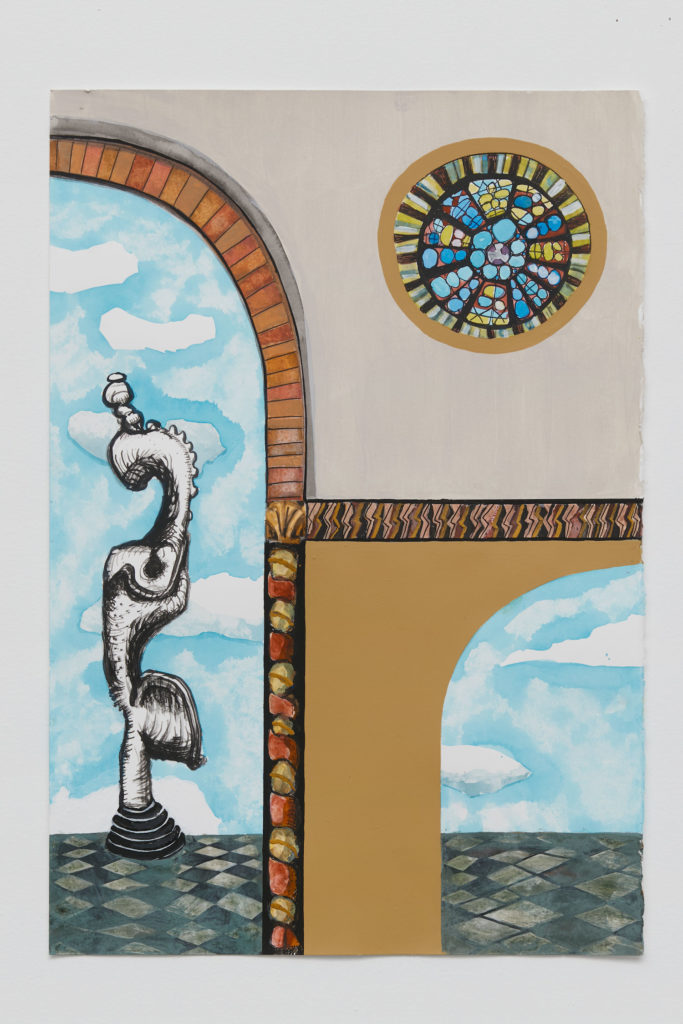
Carrie Moyer and Sheila Pepe, Opera Buffa (2020), detail. Courtesy of the artists and the Portland Museum of Art.
If I were to come across Opera Buffa in a gallery, I wouldn’t think it was done by Carrie Moyer and Sheila Pepe. It doesn’t necessarily look like your other work.
CM: I think we’ve both been pondering that, wondering, “Really, that’s what we did? How did that end up being the result?” For me, part of it was the fact that we were in this place where all of this stuff was so real and vivid. I don’t think I had a chance to process it and turn it into a kind of abstraction.
What about the title of the show, “Tabernacle for Trying Times”? The word tabernacle has varied meanings across different cultures and religions. What does it signify to you?
CM: When we were brainstorming about how we would collaborate using the gallery after we’d done the site visit, we talked about how there’s a natural gathering space in the room we were offered. So Sheila and I just started brainstorming, asking, “What are the values we want to communicate?” The phrase “big tent” came up—the idea of creating a space for all kinds of people. We were also thinking about tent revivals in the 19th century.
SP: There’s also the Jewish Tabernacles that were created when Rome destroyed the temple. They were portable tents that people would worship and use as a kind of protective space. We had a hunch that everybody could buy into this word.
CM: I grew up in a very nonreligious family, so the word tabernacle gave me the creeps for a while. [Laughs.]
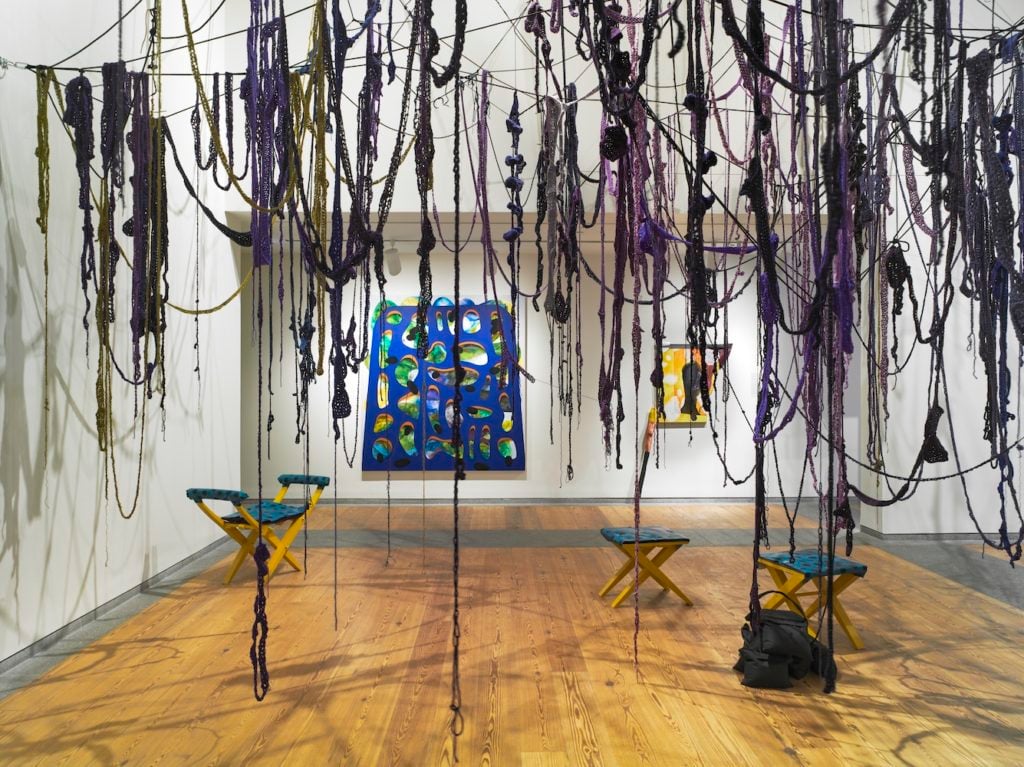
Installation view of Carrie Moyer and Sheila Pepe: Tabernacles for Trying Times” at the Portland Museum of Art. Courtesy of the Portland Museum of Art.
When you see all these works from different periods in the same space, what effect does that have?
CM: I’m someone who always thinks every painting looks really different from the last painting, even though they totally don’t. So when I was looking at all that work, the feeling I had was, “Oh, I really do know what I’m doing. I really have a group of ideas that I’ve had for quite a while.” This back-and-forth play between the kinds of space that can exist in a painting—that’s really the thing that gets me very excited. The way a painting can have one pocket where you’re convinced of its spatial reality—you feel like you can stick your hand in it—and then you move your eyes and it’s like suddenly flat. The idea that this thing could be destabilizing—I’m really interested in that. From painting to painting in that show, it’s happening in different ways.
SP: I’m asking the question too. I loved seeing those little paintings that you made 15 years ago next to something that you made last year or the year before. They looked amazing together. And they had a related palette. Even though you can put out a body of work where, in one room, every painting looks different than the other, there are these categories that keep piling up. That’s something that I love about my own work, but it’s just much more scattered, you know? My interests are more scattered. And Carrie’s a better craftsperson in painting than I am in fiber—on purpose. She’s very interested in the craft of painting. I am too, but as a visitor.
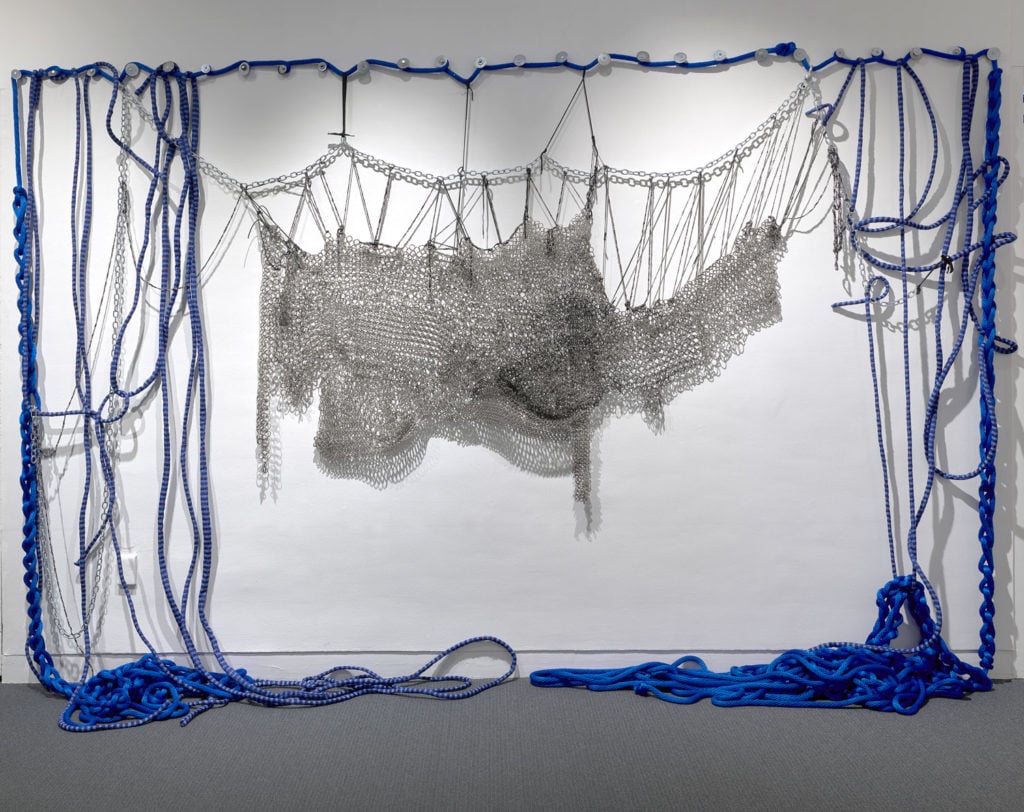
Sheila Pepe, 91 BCE, Not So Good for Emperors (2017), detail. Courtesy of the artist. Photo: Clements Photography and Design, Boston. © Sheila Pepe.
CM: Sheila doesn’t like this idea of having any kind of expertise. Though recently, she has a renewed interest in making quote-unquote “real sculpture” that stands on its own. She’s made furniture off and on for maybe the last 10 years in different shows, some of it out of crocheting. But the sculpture in this show is different—this is a very formidable object that doesn’t feel like it’s gonna disappear when you pull a string.
SP: It felt amazing to make something that was not possibly temporary or overtly ephemeral! I think it’s a couple of things. One is Carrie’s influence. I just realized this the other day actually. I always see Carrie’s paintings as these amazing objects because I just can’t see painting as anything else first. I feel like I’m joining you and working towards this new threshold problem, which is making things pretty much alone in the studio without an army of 40 people making your work. To just make something on your own with your own hands feels so luxurious. It’s less about the cult of the individual and more about the mom and pop business-scale of making good stuff.
As we move from the art world to the art industry, this is the line in the sand that I now want to draw. I also realized a couple of years ago that destroying your own work is just generally not a good idea.
CM: It defeats the feminist core of the work.
SP: Yeah, erasing yourself is not a good idea. On the other hand, it does express a value that I really believe in—that is, that art can have all of the hardcore formal attributes that we want it to, but it doesn’t need to be there forever. It can disintegrate and go back to the earth.
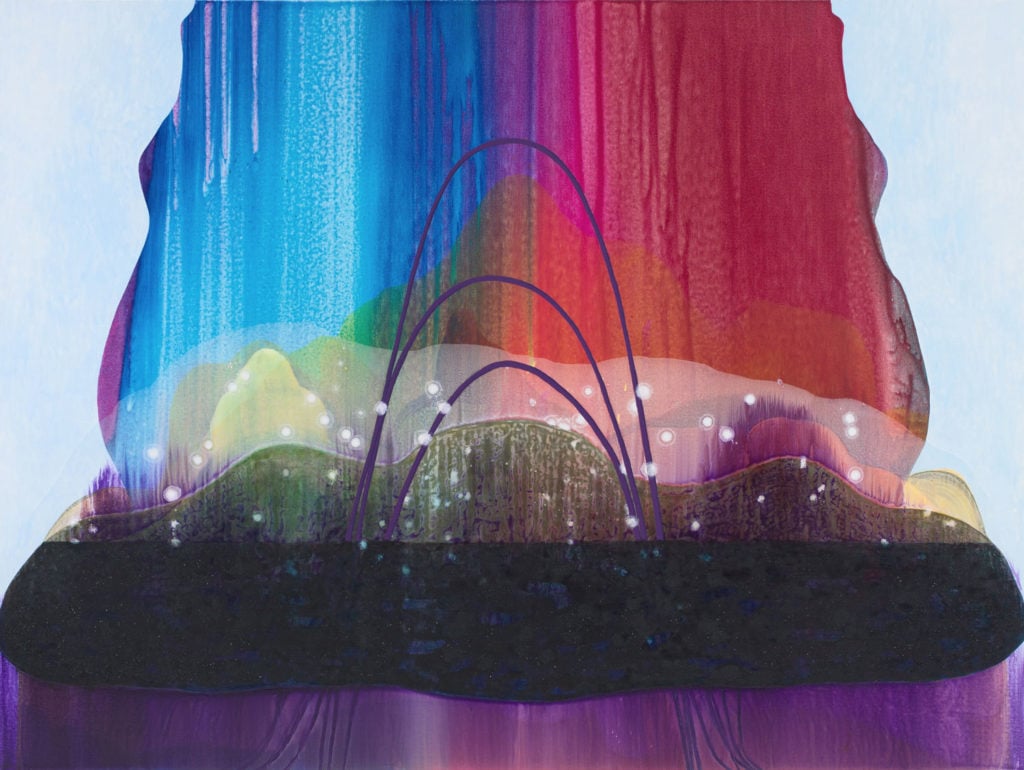
Carrie Moyer, Intergalactic Emoji Factory (2015). Courtesy of DC Moore Gallery, New York. Photo: Steven Bates. © Carrie Moyer.
Editor’s Note: the Portland Museum of Art will be closed through April 13.
“Carrie Moyer and Sheila Pepe: Tabernacles for Trying Times” is currently scheduled to be on view at the Portland Museum of Art, 7 Congress Square, Portland, Maine, February 7–June 7, 2020.